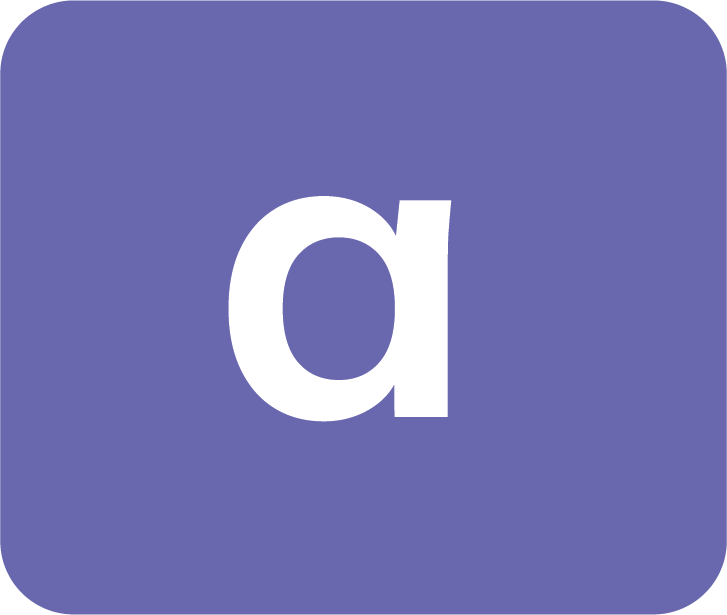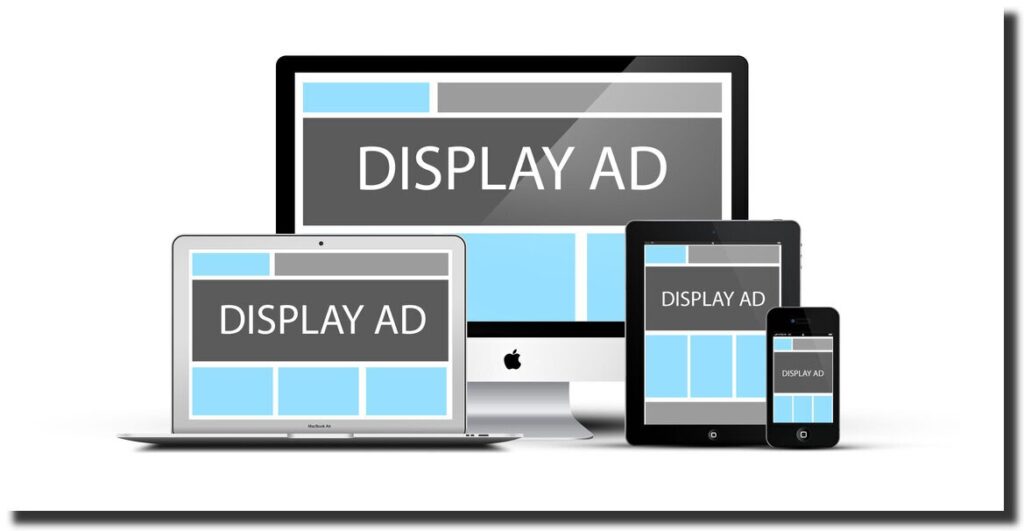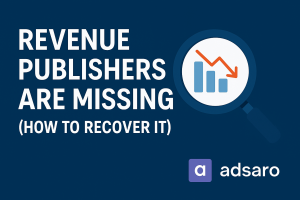When it comes to online advertising, different forms of display ads dominate the digital landscape. These visually appealing ads help businesses grab attention, promote products, and generate clicks. Whether you’re new to online marketing or refining your strategy, understanding different forms of display ads is crucial. They can make all the difference in your success.
Different Forms of Display Ads: Banner Ads

Banner ads are perhaps the most well-known type of display advertising. They appear at the top, bottom, or sides of web pages, often in rectangular shapes. Banner ads are graphic advertisements displayed on websites, typically in the form of rectangular or square images or multimedia. Among the different forms of display ads, banner ads are a classic choice for visibility, boosting brand awareness and driving website traffic. Standard banner ad sizes, as defined by the Interactive Advertising Bureau (IAB), include:
- Leaderboard (728×90 pixels): Ideal for placement at the top of web pages.
- Medium Rectangle (300×250 pixels): Commonly used within content or sidebars.
- Wide Skyscraper (160×600 pixels): Positioned on sidebars for vertical visibility.
- Mobile Banner (320×50 pixels): Optimized for mobile devices.
Benefits of Banner Ads
- High Visibility: Placed in prominent locations on websites, banner ads are hard to miss, ensuring that your brand gets noticed.
- Targeted Reach: Advertisers can target specific demographics, interests, and behaviors to ensure their ads are seen by the right audience.
- Cost-Effective: With options like CPM (Cost Per Mille), CPC (Cost Per Click), and CPA (Cost Per Action), banner ads can be tailored to fit various budgets and goals.
- Brand Awareness: Visually appealing designs help create a lasting impression and reinforce brand identity.
CLICK HERE to learn how to create and optimize an effective banner ad campaign in Adsaro.
Interstitial Ads

Interstitial ads are full-screen advertisements that appear at natural transition points in an app or website. These include moments like between game levels or during a page load. These ads are designed to grab the user’s attention by covering the entire screen, often with visually engaging content. Users must interact with the ad, either by clicking on it or closing it, to continue their experience. These ads are highly effective for capturing attention and driving engagement. Nevertheless, interstitial ads must be used strategically to avoid disrupting the user experience. As one of the different forms of display ads, interstitial ads are effective for high-impact campaigns.
Benefits of Interstitial Ads
High Visibility: Since these ads occupy the entire screen, they capture the user’s full attention, increasing the likelihood of engagement.
Better Click-Through Rates (CTR): Their immersive format often leads to higher CTR compared to banner ads.
Versatile Formats: Interstitial ads support various formats, including images, videos, and interactive elements, allowing for creative storytelling.
Improved Monetization: For publishers, these ads can generate higher revenue due to their prominent placement and performance.
Effective for Transitions: They fit seamlessly during natural breaks, such as page loads or game levels, ensuring they don’t overly disrupt the user experience.
Different Forms of Display Ads: Push Ads

Push ads are a form of advertising delivered directly to a user’s device via push notifications. These ads appear on mobile devices or desktops, often even when users are not actively engaging with an app or website. Push ads are highly effective due to their ability to target users with personalized, timely messages that encourage immediate action. Advertisers widely use them for promotions, updates, or re-engagement campaigns, offering a direct and cost-effective way to reach their audience. However, to avoid annoying users, push ads should be well-timed, relevant, and not overly frequent. Push ads are another standout among the different forms of display ads, offering direct communication.
Benefits of Push Ads
- Direct Communication: Push ads deliver messages straight to the user’s device, ensuring high visibility and immediate attention.
- Personalized Targeting: Advertisers can tailor them based on user behavior, preferences, or location, making campaigns more relevant and engaging.
- Cost-Effective: Push ads typically have lower costs compared to other ad formats, delivering excellent ROI.
- High Engagement Rates: Since push notifications are hard to ignore, they often result in better engagement and click-through rates.
- Supports Re-engagement: Push ads are great for re-engaging inactive users by sending timely updates, reminders, or promotions.
- Works Across Platforms: Push ads are compatible with both mobile and desktop devices, ensuring a wide reach.
- Instant Delivery: Messages are delivered in real-time, making them ideal for time-sensitive campaigns or offers.
CLICK HERE to learn how to create and optimize effective push campaign in Adsaro.
Rich Media Ads

Rich media ads are interactive and dynamic, incorporating elements like video, audio, or clickable buttons. These ads aim to create an engaging experience for users, encouraging them to interact with the content. Out of the different forms of display ads, rich media ads stand out for their interactive features.
These ads go beyond traditional static banner ads by offering more dynamic and immersive experiences. Users can interact with the ad, whether by clicking, swiping, or hovering over it, which encourages higher engagement and interaction. Rich media ads come in various formats, including expandable banners, video ads, and interactive in-app ads. This versatility makes them suitable for different platforms.
They are particularly effective in capturing attention and driving conversions.
Benefits of Rich Media Ads:
- Increased Engagement: The interactive nature of rich media ads encourages users to engage with the content, leading to higher interaction rates.
- Higher CTR: Due to their dynamic and visually appealing elements, rich media ads often result in better click-through rates compared to static ads.
- Better User Experience: These ads provide more immersive and enjoyable experiences, making them less intrusive while capturing attention.
- Enhanced Brand Visibility: The rich, interactive features allow advertisers to create memorable experiences that strengthen brand recognition.
- Versatile Formats: They can be customized in various ways—such as expandable banners, interactive videos, or product carousels—allowing for creative storytelling.
- Improved Conversion Rates: By offering richer content and interaction, these ads can lead to higher conversion rates, as users are more likely to take action.
- Cross-Platform Compatibility: Rich media ads work well across multiple platforms, including desktop, mobile, and tablet, ensuring broad reach.
Different Forms of Display Ads : Video Ads

With the growing popularity of video content, video ads have become a key part of display advertising. They can appear before, during, or after videos on platforms like YouTube or embedded on websites. Among the different forms of display ads, video ads excel at storytelling and engagement. These ads can appear before, during, or after video content (known as pre-roll, mid-roll, or post-roll), or even as standalone video ads on social media platforms, websites, or apps. Video ads often combine sound, motion, and visuals to create a more compelling and memorable experience. They can range from short, attention-grabbing clips to longer, more informative videos. Video ads are highly effective for driving brand awareness, educating users about a product or service, and encouraging conversions.
Benefits of Video Ads
- High Engagement: The dynamic nature of video content captures attention more effectively than static ads, leading to higher engagement rates.
- Better Storytelling: Video allows brands to convey their message in a more creative and emotionally compelling way, making it easier to connect with audiences.
- Improved Conversion Rates: The combination of visual and auditory elements makes video ads more persuasive, often leading to higher conversion rates.
- Increased Brand Awareness: Users are more likely to share videos, increasing the potential for viral reach and greater brand visibility.
- Better Retention: Video ads can be more memorable, helping brands leave a lasting impression on their audience.
- Versatile Platforms: They can be used across multiple platforms, from social media to streaming services, websites, and mobile apps, maximizing reach.
- Clear Communication: They can effectively showcase products or services, providing users with a clear understanding of what’s being offered.
- Targeting Capabilities: Advertisers can customize video ads with advanced targeting options based on user demographics, interests, and behavior, ensuring relevance.
Native Ads

Native ads seamlessly blend into the website’s content, making them less intrusive. They match the platform’s design and are often labeled as “sponsored” or “promoted” content. These are subtle yet effective among the different forms of display ads. Unlike traditional ads, which can be disruptive, native ads are designed to look like part of the user experience, making them less intrusive. These ads can appear in various forms, such as sponsored articles, in-feed ads on social media, or recommended content on websites. The goal of native ads is to provide valuable, relevant content while subtly promoting a product or service. This leads to higher engagement and better user reception.
Benefits of Native Ads
- Enhanced User Experience: Since native ads blend seamlessly with the content, they provide a non-disruptive experience, making them more acceptable to users.
- Higher Engagement: Their relevance and non-intrusive nature encourage more interaction, often resulting in higher click-through rates (CTR) compared to traditional ads.
- Better Brand Perception: Native ads can improve brand perception by offering value through informative or entertaining content, rather than feeling like a hard sell.
- Increased Trust: Because they mimic the style of the platform’s regular content, native ads often gain perception as more trustworthy and less like traditional advertising.
- More Effective Targeting: Advertisers can tailor native ads to fit specific audience interests, ensuring they reach the right people and increasing relevance and engagement.
- Improved Ad Performance: With the ability to appear in contextually relevant environments, native ads often perform better than banner or display ads.
- Less Ad Fatigue: Since native ads are designed to feel natural and unobtrusive, they reduce the likelihood of users experiencing ad fatigue, leading to better long-term results
CLICK HERE to learn to create and optimize effective Native Ad Campaigns in Adsaro.
Retargeting Ads

Advertisers display retargeting ads to users who have previously visited their website. These ads help re-engage potential customers and encourage them to complete an action, such as making a purchase. Retargeting ads are a strategic choice among the different forms of display ads for conversion-focused campaigns. These ads follow users across different websites or platforms, serving targeted content based on their past interactions. This encourages them to return and complete the conversion. Retargeting is an effective way to increase conversions by reminding users of products they showed interest in. It can also offer additional incentives, like discounts, to prompt action.
Benefits of Retargeting Ads
- Increased Conversion Rates: By reminding users about products or services they’ve previously shown interest in, retargeting helps bring them back, increasing the likelihood of conversion.
- Improved ROI: Retargeting targets warm leads—users who have already interacted with the brand—leading to higher efficiency and return on investment (ROI).
- Better Brand Recall: Frequent exposure to retargeting ads keeps the brand top-of-mind for users, making them more likely to choose it when ready to take action.
- Personalized Messaging: Advertisers can customize retargeting ads based on the user’s past behavior, offering relevant content and personalized offers to drive further engagement.
- Cost-Effective: Since the ads target users who have already expressed interest, retargeting can be more cost-effective than broad, untargeted campaigns.
- Helps with Cart Abandonment: Retargeting is particularly effective in e-commerce, helping recover abandoned shopping carts by nudging users to complete their purchases.
- Increased Engagement: Re-engaging users who have interacted with a brand previously increases the likelihood of further interactions and deeper brand engagement.
- Cross-Platform Reach: Retargeting ads can follow users across multiple platforms, ensuring consistent messaging across web, mobile, and social media channels.
Social Media Display Ads

Social media platforms like Facebook, Instagram, and LinkedIn offer display ad options tailored to their audiences. These ads can range from static images to dynamic carousels and stories. Social media ads are among the most versatile different forms of display ads. Social media ads offer advanced targeting based on demographics, interests, behavior, and location. This helps advertisers reach their ideal audience effectively. With interactive features, social media ads can drive actions like clicks, likes, shares, and purchases. This makes them a powerful tool for brand awareness and conversions.
Benefits of Social Media Ads
- Precise Targeting: Social media platforms offer detailed targeting options, allowing advertisers to reach specific audiences based on demographics, interests, behaviors, location, and more.
- High Engagement: Social media ads encourage interaction, whether through likes, comments, shares, or direct responses, which increases user engagement.
- Brand Awareness: With billions of active users on platforms like Facebook and TikTok, these ads can help increase visibility and brand recognition on a global scale.
- Cost-Effective: Social media advertising can be relatively affordable, especially with flexible budgeting options, making it accessible for businesses of all sizes.
- Diverse Ad Formats: From video ads to carousels, stories, and sponsored posts, they offer a variety of formats to suit different campaign objectives.
- Real-Time Analytics: Social media platforms provide real-time performance data, allowing advertisers to track their campaigns and make data-driven adjustments quickly.
- Cross-Platform Reach: Advertisers can display ads across multiple platforms, helping them reach users on their preferred social media networks.
- Increased Conversions: These ads, with clear CTA and integrated shopping features, can drive direct sales, sign-ups, and other valuable actions.
- Viral Potential: Well-targeted and engaging social media ads have the potential to go viral. This in turn, reaches a much larger audience organically through shares and word-of-mouth.
Why Understanding Different Forms of Display Ads Matters
Choosing the right form of display ad depends on your goals, target audience, and budget. Whether you’re aiming to boost brand visibility, drive clicks, or increase conversions, there’s a display ad format to meet your needs.
By exploring the different forms of display ads, you can craft a strategy that resonates with your audience and maximizes your return on investment. Understanding and leveraging the different forms of display ads can position your brand for success in the digital world.








Leave a Reply